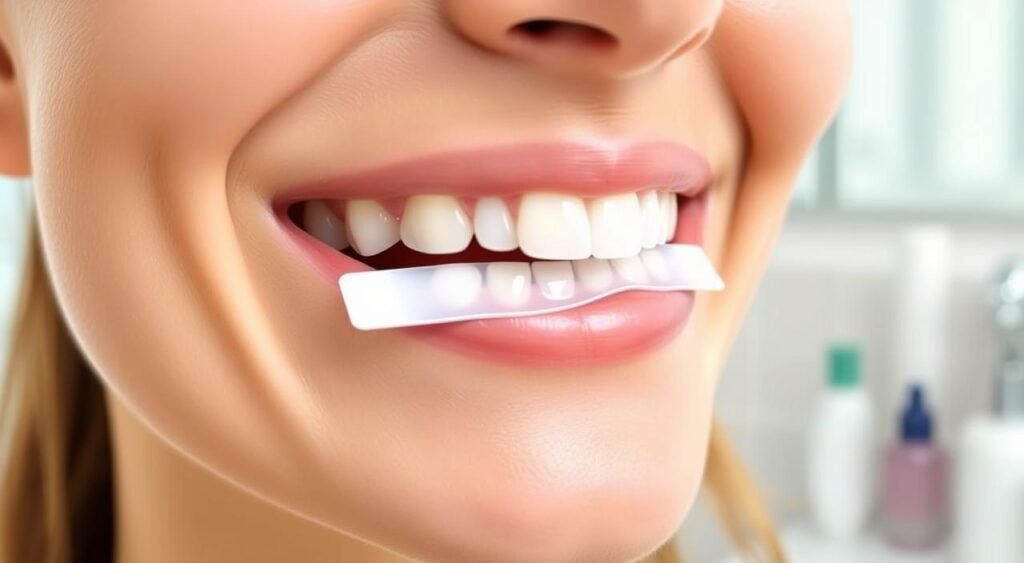Do teeth whitening strips expire? Ever found an old box of whitening strips in your bathroom and wondered if they’re okay to use? You’re not alone. Many people are unsure if using expired whitening strips can harm their teeth.
Knowing how long teeth whitening products last is key for a perfect smile. Whitening strips are easy to use at home but lose their power over time. Understanding how long they last can help you get the best results and avoid risks.
Did you know whitening strips last 1-2 years from when they’re made? This info is on the packaging, under labels like “Best if Used By” or “Expiration Date.” Using old strips can weaken their bleaching power and lead to uneven whitening.
In this article, we’ll look at what affects how long whitening strips last, signs they’ve expired, and the dangers of using them too late. We’ll also talk about other ways to brighten your smile when your strips are no good. Let’s explore what you need to know about teeth whitening strips validity.
Understanding Teeth Whitening Strips
Teeth whitening strips are a favorite for those wanting a brighter smile. They are easy to use at home. Let’s explore what they are, how they work, and some top picks.
What are teeth whitening strips?
Teeth whitening strips are thin, flexible pieces of plastic with a gel on them. This gel is peroxide-based. They fit over your teeth, delivering the whitening agent right to the surface. Most strips stay effective for 12-18 months.
How do they work?
The strips keep the gel on your teeth for a set time. The peroxide in the gel breaks down stains. For the best results, use them before they expire.
Popular brands and types
Crest 3D White Whitestrips are a top choice. They have many options for different needs:
- Crest 3D Whitestrips Professional Effects: Priced at $45 (discounted from $90)
- Crest Whitening Emulsions with LED Accelerator Light: $70
- Crest 3D Whitestrips Original + LED Light: $75
These products meet various preferences and budgets. Choose the best one for your whitening needs. Always check the expiration date for fresh strips.
Do Teeth Whitening Strips Expire?
Yes, teeth whitening strips do expire. You can find the expiry date on the packaging. Most strips last 1-2 years from when they were made. This answers the question: how long do whitening strips last?
Strips lose their strength over time because of the active ingredients. As they age, the bleaching agents weaken. This means you might not see the results you want if you use them too long after they expire.
- Weaker bleaching power
- Uneven whitening
- Increased tooth sensitivity
- Poor adhesion to teeth
To get the best results, always check the expiry date before using. Start your whitening treatment right after buying and finish it before the strips expire. This way, you’ll get the best results and achieve a bright smile.
Factors Affecting Whitening Strip Shelf Life
The durability of teeth bleaching strips depends on several key factors. Knowing these can help you use your whitening strips to the fullest.
Storage Conditions
Proper storage is key for keeping your whitening strips effective. Store them in a cool, dry spot, away from sunlight. Heat and light can damage the active ingredients, making them less potent.
Packaging Integrity
Sealed packaging keeps whitening strips safe from air and moisture. Once opened, they start to break down. Always check the packaging for any damage before using.
Active Ingredients
The main whitening agent in strips is hydrogen peroxide. This compound degrades over time, impacting the strips’ whitening power. The expiration date is based on when these ingredients lose their effectiveness.
- Store in a cool, dry place
- Keep packaging sealed until use
- Check expiration dates before applying
- Use within 6-12 months of opening for best results
By considering these factors, you can keep your teeth whitening strips effective until their expiration date. Always follow the manufacturer’s instructions for the best results and safety.
Signs of Expired Whitening Strips
It’s important to know when your whitening strips have expired. This keeps them fresh and effective. Most products last 1-2 years from when they’re made. But, this time can change.
Here are signs your strips might be past their best:
- Changes in gel consistency
- Altered strip texture
- Reduced adhesiveness
- Unusual color or odor
- Damaged packaging
If you see any of these signs, it’s time for new strips. Whitening strips don’t always have an expiration date on them. So, it’s key to watch for these physical signs.
Storing your strips right is also important. Light can make the whitening agent less strong. Keep them in a cool, dark spot. Even if they look good, change them every 1-2 years for the best results and safety.

Using Expired Whitening Strips: Risks and Considerations
Understanding the risks of using expired teeth whitening products is key. You might think about using old strips in your bathroom. But, it’s vital to think about the possible downsides.
Safety Concerns
Expired whitening strips might not be harmful right away. But, they could cause problems. The adhesive might not stick well to your teeth.
This can lead to uneven whitening and gum irritation. It’s not worth the risk.
Reduced Effectiveness
The expiration date on whitening products is not just a guideline. Over time, the strips’ active ingredients weaken. This means you won’t get the results you hope for.
You might spend time and effort on a treatment that doesn’t work well. It’s a waste of time.
Potential Side Effects
Expired strips can make your teeth more sensitive. The breakdown of ingredients might harm your enamel or gums. It’s safer to use fresh products.
- Increased tooth sensitivity
- Uneven whitening results
- Possible gum irritation
- Risk of enamel damage
Always get a dentist’s opinion before whitening your teeth. They can give advice based on your dental health. They’ll suggest safe and effective ways to brighten your smile.
Conclusion
Knowing when dental whitening strips expire is key to getting the best results. These products usually last 1-2 years. It’s important to check the expiration date before using them.
Expired strips might not harm you, but they won’t work as well. This could mean your teeth don’t get as white as you hope.
Prices for teeth whitening vary a lot. You can find over-the-counter options for $10 to $50. Professional treatments can cost up to $800.
Crest is a well-known brand with a range of products. Their 3D Whitestrips Professional Effects Value Pack is now $45, down from $90. Buying fresh products is the best way to get good results.
To keep your smile bright, replace whitening products every 1-2 years or when the expiration date says so. If you’re using DIY methods, be careful. Always talk to a dental professional to avoid any problems.
By choosing fresh products and following the right guidelines, you can safely brighten your smile.
FAQ – Teeth Whitening Strips
Do teeth whitening strips expire?
Yes, teeth whitening strips do expire. Most brands, like Crest 3DWhitestrips, have a “best if used by” date on the box. The whitening agent’s power fades over time. So, it’s best to use them before the expiration date for the best results.
How long do teeth whitening strips typically last?
Teeth whitening agents usually work for about a year after they’re made. But, how long they last can change. This depends on how you store them, the packaging, and the ingredients.
What happens if I use expired whitening strips?
Using expired whitening strips is generally safe. But, they won’t work as well. The peroxide-based ingredients break down, leading to less whitening. There’s also a small chance of tooth sensitivity or gum irritation.
How can I tell if my whitening strips have expired?
Expired whitening strips might look different. They could have changed gel consistency, texture, color, or smell. If the packaging is damaged, the strips might not stick well or dry out.
How should I store teeth whitening strips to prolong their shelf life?
Keeping whitening strips fresh is key. Don’t expose them to too much heat or sunlight. This can make the whitening agent degrade faster. Always store them in their original packaging in a cool, dry spot.









1 Comment
Pingback: How Long Does Teeth Whitening Take? Quick Guide